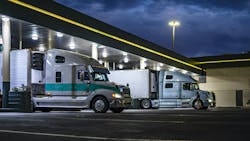Akin: Why universal tiered discounts may beat flat rebates in a volatile fuel market
Key takeaways:
- Greater value with tiered discounts that reward actual fuel consumption and adapt to price fluctuations.
- Increased operational flexibility by allowing refueling at more than 95% of stations without brand restrictions, reducing detours and saving time.
- Accessible tier levels through modern platforms like RoadFlex, providing better savings for medium and large fleets without traditional brand limitations.
In today’s volatile fuel market, flat rebates tied to specific brands often fall short of delivering consistent value. Medium and large fleets with meaningful monthly volume can unlock far greater savings by switching to universal tiered discount structures—especially those that don’t restrict usage to a narrow set of branded stations. Smart fleet managers are now shifting to modern tier-based models that reward real fuel usage without sacrificing operational flexibility.
The problem with flat rebates and brand restrictions
Flat rebates, such as a fixed 3 or 5 cents per gallon, can be appealing at first glance, but they quickly lose their edge when fuel prices fluctuate wildly, as they have over the past few years. Worse yet, when these rebates are limited to specific branded stations, the discount may not even cover the premium pricing at those locations. And let’s not forget the time and mileage wasted when drivers have to reroute to access the “eligible” station.
Brand-tied flat rebates have the following limitations:
- Low reward potential: Discounts don’t scale with volume.
- Geographic restrictions: They are limited to certain brands or networks.
- Price inefficiencies: The “discount” may apply to stations with already inflated prices.
- Operational friction: Drivers are forced to adapt routes just to capture a minor benefit.
Why tiered discounts outperform in a dynamic fuel environment
In contrast, tiered universal discount models reward actual fuel consumption, delivering increasingly better rates as fleets scale their monthly gallon usage. These models are particularly beneficial for medium to large fleets—those purchasing 5,000-plus gallons monthly—that can climb into top tiers that often rival or beat the discounts offered by branded programs.
Universal tiered models have the following benefits:
- Scalable discounts: Higher volume = better rates.
- Universal acceptance: Discounts apply across 95%-plus of stations.
- Market protection: Tiered structures provide more consistent value even as fuel prices spike or dip.
- No need for detours: Drivers refuel where it makes the most sense, saving time, fuel, and labor.
See also: Akin: Fuel smarter: How route-based automation finds the best rebates in real time
The trap of unrealistic tiers from traditional players
Legacy fuel card providers often advertise tiered programs, but the catch is in the fine print. Their highest discount tiers are frequently unreachable for all but the largest enterprise fleets. And even then, those top-tier rebates still only apply at select branded stations—meaning a driver might burn fuel just to reach the “discount” location.
A few examples of pitfalls are:
- Unattainable thresholds: 100,000-plus gallons/month required for top tiers.
- Brand limitations: Tiers only apply at Exxon, Shell, or another single brand.
- Hidden fees: Tier discounts offset by transaction or network fees.
Modern tiers, modern results
New-generation platforms like RoadFlex offer realistic and transparent tier structures based on total monthly gallons—across all brands. Medium fleets can reach top-tier discounts with as little as 5,000 to 10,000 gallons per month. This provides access to rebates that rival or beat those of traditional fuel cards without any brand restrictions or extra effort.
Case example:
- A logistics fleet consuming ~8,000 gallons/month switched to RoadFlex’s universal tiered model.
- Within the first quarter, it accessed top-tier rebates of up to 10 cents per gallon, comparable to brand-specific “elite” tiers.
- Unlike traditional cards, the discount is applied across a wide station network, reducing both cost and driver downtime.
How to evaluate tiered programs
When assessing fuel programs, ask the following questions:
- Are the tiers based on realistic volumes for my fleet?
- Do the discounts apply universally or only to a specific brand?
- Are there extra hoops (apps, codes, station searches) to unlock the rebate?
- Is the provider transparent about thresholds and pricing?
Final take
In a fuel market that’s anything but stable, the smarter move for fleets is to align incentives with real usage. Universal tiered discounts reward scale, improve flexibility, and drive meaningful savings without complicating driver behavior. If your current fuel card limits you to flat rebates or brand-specific discounts, it’s time to rethink your strategy. The best discounts aren’t just bigger; they’re smarter, broader, and built for how modern fleets operate.
About the Author

Rush Akin
Rush is an experienced veteran in the fleet industry, with over 20 years of experience in fleet management. Before joining RoadFlex, Rush served as the SVP of sales for Solera, where he was in charge of overseeing fleet sales and business development in North America. Prior to Solera, Rush worked with well-known brands in the industry, such as Rand McNally, Lytx, FourKytes, and Syntech Systems Fuel Master. Rush has a strong background in fleet and fuel management, as well as customer success.
